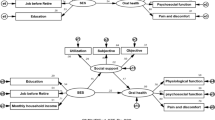Abstract
Background
Psychosocial factors largely external to the individual—such as social support and those that are inherently dispositional, like optimism—may both play a role in determining oral health outcomes and serve to buffer the effect of each other.
Purpose
The aim of this study was to assess associations of social support and optimism on oral health.
Method
In 2005–2006, n = 1,859 persons around 30 years old were surveyed to collect data on social support, optimism, oral health-related quality of life, and caries experience.
Results
Unadjusted analyses found high social support associated (P < 0.05) with fewer (mean ± SE) decayed teeth (0.6 ± 0.1) and less negative impact on quality of life (2.7 ± 0.2) compared to low support (1.0 ± 0.2 and 4.5 ± 0.4 respectively). High optimism was associated with fewer missing teeth (2.1 ± 0.2) and less negative impact on quality of life (2.1 ± 0.2) compared to low optimism (2.9 ± 0.2 and 3.8 ± 0.2, respectively). Multivariate regressions adjusted for dental visiting, toothbrushing, sex, income, work status and education showed social support and optimism had (P < 0.05) negative associations with missing teeth (β = −1.0) and caries experience (β = −1.5) for high support/high optimism compared to low support/low optimism. All three non-reference combinations of support/optimism showed negative associations (β = −1.6 to −2.4) with impact of problems compared to low support/low optimism.
Conclusions
Social support and optimism were associated with oral health. Impact of dental problems showed buffering of high support when optimism was low, and high optimism when support was low.



Similar content being viewed by others
References
Dahlem NW, Zimet GD, Walker RR. The multidimensional scale of perceived social support: a confirmation study. J Clin Psychol. 1991;47:756–61.
Ylostalo PV, Ek E, Laitinen J, Knuuttila ML. Optimism and life satisfaction as determinants for dental and general health behaviour—oral health habits linked to cardiovascular risk factors. J Dent Res. 2003;82:194–9.
Kaplan RM, Sallis JF, Patterson TL. Health and human behaviour. Singapore: McGraw-Hill; 1993. Chapter 7.
Hanson BS, Liedberg B, Owall B. Social network, social support and dental status in elderly Swedish men. Community Dent Oral Epidemiol. 1994;22:331–7.
Ylostalo PV, Knuuttila MLE. Coping and optimism in relation to dental health behaviour—a study among finnish young adults. Eur J Oral Sci. 2003;111:477–82.
Berkman LF, Glass T. Social integration, social networks, social support, and health. In: Berkman LF, Kawachi I, editors. Social epidemiology. (chapter 7). NY: Oxford University Press; 2000.
Scheier MF, Carver CS. Optimism, coping and health: assessment and implications of generalized outcome expectancies. Health Psychol. 1985;4:219–47.
Newton JT, Bower EJ. The social determinants of oral health: new approaches to conceptualising and researching complex causal networks. Community Dent Oral Epidemiol. 2005;33:25–34.
Young C. Are young people leaving home earlier or later? J Aust Popul Assoc. 1996;13:125–52.
Roberts-Thomson KF, Stewart JF. Access to dental care by young South Australian adults. Aust Dent J. 2003;48:169–74.
Dillman DA. Mail and telephone surveys. The total design method. NY: Wiley; 1978.
NIDR. Oral health surveys of the National Institute of Dental Research. Diagnostic criteria and procedures. Washington: US Department of Health and Human Services; 1987.
Slade GD. Derivation and validation of a short-form oral health impact profile. Community Dent Oral Epidemiol. 1997;25:284–90.
Fleiss JL. The design and analysis of clinical experiments. NY: Wiley; 1986.
Mangione TW. Mail surveys. Improving the quality. CA: Sage; 1995.
Yammarino FJ, Skinner SJ, Childers TL. Understanding mail survey response behaviour. A meta-analysis. Public Opin Q. 1991;55:613–99.
Asch DA, Jedrziewski MK, Christakis NA. Response rates to mail surveys published in medical journals. J Clin Epidemiol. 1997;50:1129–36.
Allister JH, Spencer AJ, Brennan DS. Provision of orthodontic care to adolescents in South Australia: the type, the provider and place of treatment. Aust Dent J. 1996;41:405–10.
Topping G, Assaf A. Strong evidence that daily use of fluoride toothpaste prevents caries. Evid Based Dent. 2005;6:32.
Slade GD, Spencer AJ, Roberts-Thomson KF. Australia’s dental generations. The national survey of adult oral health 2004–06. Canberra: Australian Institute of Health and Welfare; 2007.
Watson D, Pennebaker JK. Health complaints, stress, and distress: exploring the central role of negative affectivity. Psychol Rev. 1989;96:234–54.
Kressin NR, Spiro 3rd A, Skinner KM. Negative affectivity and health-related quality of life. Med Care. 2000;38:858–67.
Kressin NR, Reisine S, Spiro 3rd A, Jones JA. Is negative affectivity associated with oral quality of life? Community Dent Oral Epidemiol. 2001;29:412–23.
Brennan DS, Singh KA, Spencer AJ, Roberts-Thomson KF. Positive and negative affect and oral health related quality of life. Health Qual Life Outcomes. 2006;4:83.
Acknowledgements
The study was supported by a Research and Development Grants Advisory Committee grant, the South Australian Dental Service, and South Australian Health Commission in 1988–1989; and a National Health and Medical Research Council project grant (299057) in 2005–2006 and Career Development Award (627037).
Author information
Authors and Affiliations
Corresponding author
Rights and permissions
About this article
Cite this article
Brennan, D.S., Spencer, A.J. Social Support and Optimism in Relation to the Oral Health of Young Adults. Int.J. Behav. Med. 19, 56–64 (2012). https://doi.org/10.1007/s12529-010-9136-3
Published:
Issue Date:
DOI: https://doi.org/10.1007/s12529-010-9136-3




